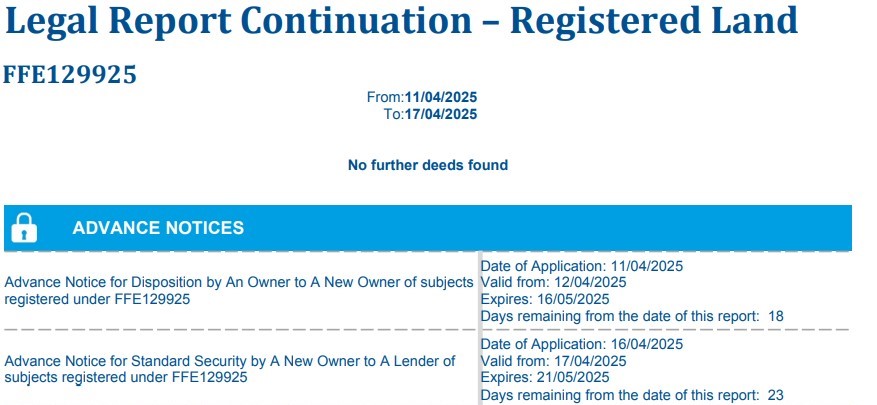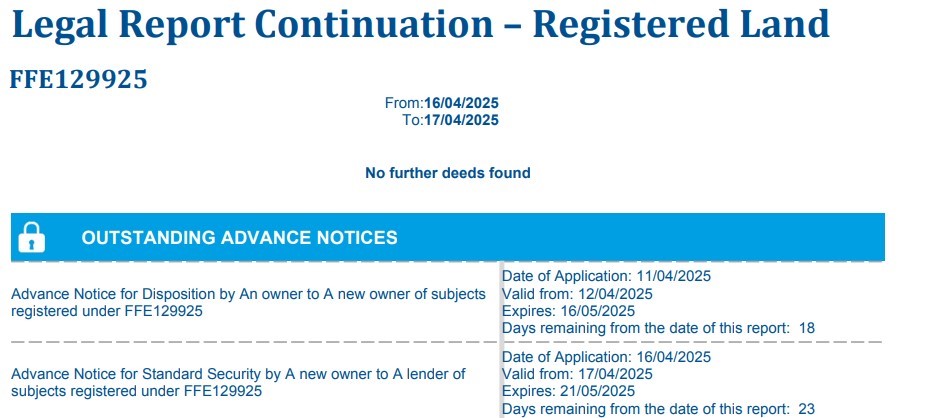Following feedback from customers, we are making a change to how we show outstanding Advance Notices (ANs) on our Legal Report Updates.
Our current practice is to show any AN on a Legal Report (LR) if the AN was registered or recorded in the period that LR covers. We apply the same principle for Legal Report Updates (LRU), so if an AN was submitted prior to the LRU it will have been shown on the original LR so we don’t currently show it on an update.
It’s not uncommon to get a follow up query if we haven’t shown an active AN on a LRU even if it has been shown on the original LR. We’d like to reduce this confusion, report the position more clearly and allow users to rely solely on the LRU without having to refer back to the original LR to see all outstanding ANs.
When will this change take effect?
Our change, which is effective in the next few weeks, relates to the LRU. We will continue to show ANs on a LR if they are registered or recorded in the period that LR covers, however when we provide an LRU, we will report from the date of the original LR for any changes to the title, additional deeds submitted etc (as we currently do), in addition we will show all outstanding ANs, including any that might have previously been shown on a LR.
This will provide a clearer current position and will also reduce the need to refer back to an original LR.


Support & Feedback
We hope that you agree that this updated process will make the position on ANs clearer at the point of settlement use but of course if you have any issues or feedback we’d be delighted to hear from you.
For further information please contact the Millar & Bryce Customer Relationship team who will be happy to assist you: relationship@millar-bryce.com
Share this post on social media
Our services
Estate Agency Services
Residential Conveyancing
Land and Property
Commercial Real Estate
Private Client
Integrated Search & Order Solutions
Property searches are a cornerstone of Scottish conveyancing. No property transaction can complete without searches of the Land Register, Register of Inhibitions, Companies House, even the outgoing Register of Sasines, until all Scottish property is registered on the Land Register. Since the 19th century, professional searchers have handled the technical heavy lifting, but conveyancers need to understand what’s needed – and why – to shape our daily practice. The reality is that thorough searches and enquiries protect both our clients and our firms.
The golden rule of property searches is to order early. By getting ahead of the game, there is breathing space to address whatever comes up. There are, of course, those searches that need to be current at the time of transaction, ordered immediately before settlement. Even then timing really is everything to avoid adding more stress to an already intense situation for clients and Millar & Bryce are experts at delivering these time sensitive searches, early on the day that you need them..
Navigating registration status
There are two paths for searches in Scotland, each depends on whether you’re dealing with property already in the Land Register or if it’s still in the Sasine Register, yet to be added to the Land Register.
Unregistered properties
Unregister properties need a legal report (unregistered), so they can be added to the Land Register. In a legal report, you describe the property so it can be identified on the Sasine Register, which, in this case, is the source of the search.
The legal report (unregistered) response will detail:
- all relevant common entries within a 40-year Sasine search period
- the prescriptive progress of title being an unbroken chain of titles going back at least ten years
- any outstanding securities in that ten-year period
- any discharges recorded in the preceding five years
- any alienations from the property description
- whether the property is already subject to registration in the Land Register
- any valid advance notice recorded to protect an intended deed (not a transaction) between two or more parties for a 35-day protected period
Since the Land Registration etc. (Scotland) Act 2012 (LRE(S)A 2012) introduced no registration without mapping, all properties need to be on a plan that shows the boundaries match the title deeds as well as the OS map, cadastral map and that there are no conflicts with any already registered titles.
To make sure this happens, there are three levels of report, each delivering another level of information, but most practitioners choose the most comprehensive report, Level 3. As well as checking the maps, boundaries and other registered deeds, it identifies conflicts with existing cadastral units and provides an illustrative print showing the extent of the competition. It also discloses relevant information, including servitudes, real burdens and other registered interests, such as minerals.
Yes, they cost more, but the detail of level 3 plans can flag potential issues and alert you to mapping issues before submitting an application for registration – and if an existing deed plan is not suitable for registration, it is simple to get a new deed plan from Millar & Bryce that conforms to the Keeper’s deed plan criteria.
Registered properties
A legal report (registered) lays out the details on the title sheet or application record in the Land Register. Much more streamlined, legal report (registered) confirms or discloses:
- changes to the postal address and current ownership details
- outstanding charges affecting the property
- leases or real burdens affecting the property
- details of miscellaneous burden deeds or alienations registered after the current proprietorship or on the title sheet as a schedule of removals
- valid advance notices entered in the application record
While a title number is technically enough for identification, using the full address does help prevent those awkward moments when similar numbers lead to confusion. It’s a small step that can prevent significant complications.
For both registered and unregistered legal reports, the seller’s conveyancer usually orders a continuation to cover the period between its arrival and the settlement of the transaction, so all the information is up to date at hand over.
Universal search requirements
There are standard searches for all transactions, specifically personal searches and property enquiry certificates. Personal searches check if there is anything that inhibits the person from selling, like bankruptcy, court notices. The property enquiry certificate (PEC) gathers information on the status of a property from local authority data sources and statutory registers, covering:
- planning
- building control
- statutory notices
- roads
- water and sewerage
- contaminated land
When buying property from a company, you should request a company search to scrutinise the information available on Companies House as well as more specific company checks
- the register of charges to disclose outstanding entries and any adverse notices relating to liquidation, receivership, administration order, winding up or striking off
- the register of insolvencies for all Scottish registered companies
- the company file, to disclose the current directors and secretary (and registered office)
When searches raise red flags
Should search results reveal unexpected complications, the best approach is to take action quickly and share advice and practical solutions with the client. But this can only work effectively if the searches were ordered with plenty of time for those red flags to not derail the transaction – risk management is essential.
Managing the process
Balancing thoroughness with efficiency equates to successfully managing searches. While maintaining comprehensive records might not be the most exciting part of the job, it prevents oversights and helps justify actions if or when questions arise later. Early communication about potential issues generally leads to better outcomes than last-minute surprises.
Looking forward
As the profession continues to evolve, understanding search requirements remains crucial. While you can delegate the technical work to professional searchers, keeping an eye on the process protects both your clients and our practice.
By understanding the searches’ purpose and maintaining appropriate procedures, you can ensure they serve their intended protective function. After all, effective conveyancing combines technical knowledge with practical judgment. And while technology and registration systems may change, the fundamental need to understand what we’re dealing with remains constant. Staying alert to these requirements helps ensure we continue to serve our clients effectively while protecting our professional interests.
Share this post on social media
Our services
Estate Agency Services
Residential Conveyancing
Land and Property
Commercial Real Estate
Private Client
Integrated Search & Order Solutions
Millar & Bryce at 150: Property Excellence Past, Present & Future is taking place on Wednesday 14th May at Dynamic Earth, Edinburgh.
Find out what will be shaping the Scottish property market in 2025 and beyond as industry leaders share their insights over a broad range of topics.
Millar & Bryce considers that this event represents five hours of continuing professional development activity, however each attendee must consult the rules of their individual accreditation scheme or professional body if they require confirmation.
Full agenda below:
12 NOON
Registration & fork-buffet networking lunch
12:45PM
Welcome
Conference Host, David Lee
12:50-13:10PM:
A long and proud history of innovation: 150 years of Millar & Bryce
Richard Hepburn, Director Scotland, Millar & Bryce
13:10 – 13:30PM:
Serving the clients of today with honesty, authenticity and technology
Gary Donaldson, Operations Director & Lorna Kerr, Sales Director, Millar & Bryce
13:30 – 13:50PM:
Advancing into digital transactions: do we need to go faster?
Ann Stewart, Property and Professional Development Adviser, Shepherd and Wedderburn
13:50 – 14.10PM:
Sustainability. Navigating the Future, with Confidence
Chris Loaring, Sustainability Director, Landmark Information Group
14:10-14:40PM
Keynote: The Property Buyer of the Future: What You Need to Know
William Ullstein, CEO – UK, YouGov
14:40PM:
Coffee break & networking
15:05 – 15:30PM:
The Use of GenAI in Property Due Diligence
Yayoi Teramoto, Data Scientist, Landmark Information Group
15:30 – 15:50PM:
Bringing it all together
Mike Holden, Divisional Director of Growth, Landmark Information Group
15:50 – 16:25PM:
Panel discussion: a property sector fit for the 21st century
Jill Andrew, Partner, Connell & Connell, Chair of Edinburgh Conveyancers Forum | Alan Cumming, Head of Sales & Financial Services, Rettie | Lyndsay Gowans, Director, DHKK Chartered Surveyors | Mike Holden, Divisional Director of Growth, Landmark Information Group
16:25PM:
Closing remarks
Simon Brown, CEO, Landmark Information Group
On closing we will head back to the Ozone & Stratosphere conference space for drinks & canapes, whilst taking in the stunning views of Arthur’s Seat and the Salisbury Crags.
Share this post on social media
Our services
Estate Agency Services
Residential Conveyancing
Land and Property
Commercial Real Estate
Private Client
Integrated Search & Order Solutions
Get in touch
Get in touch with our team of experts to tell us about your requirements, ask a question or request a demo.
Address
Millar & Bryce
First Floor, East Wing,
Lochside House,
3 Lochside Way,
Edinburgh,
EH12 9DT
© 2025 Millar & Bryce. All rights reserved.







